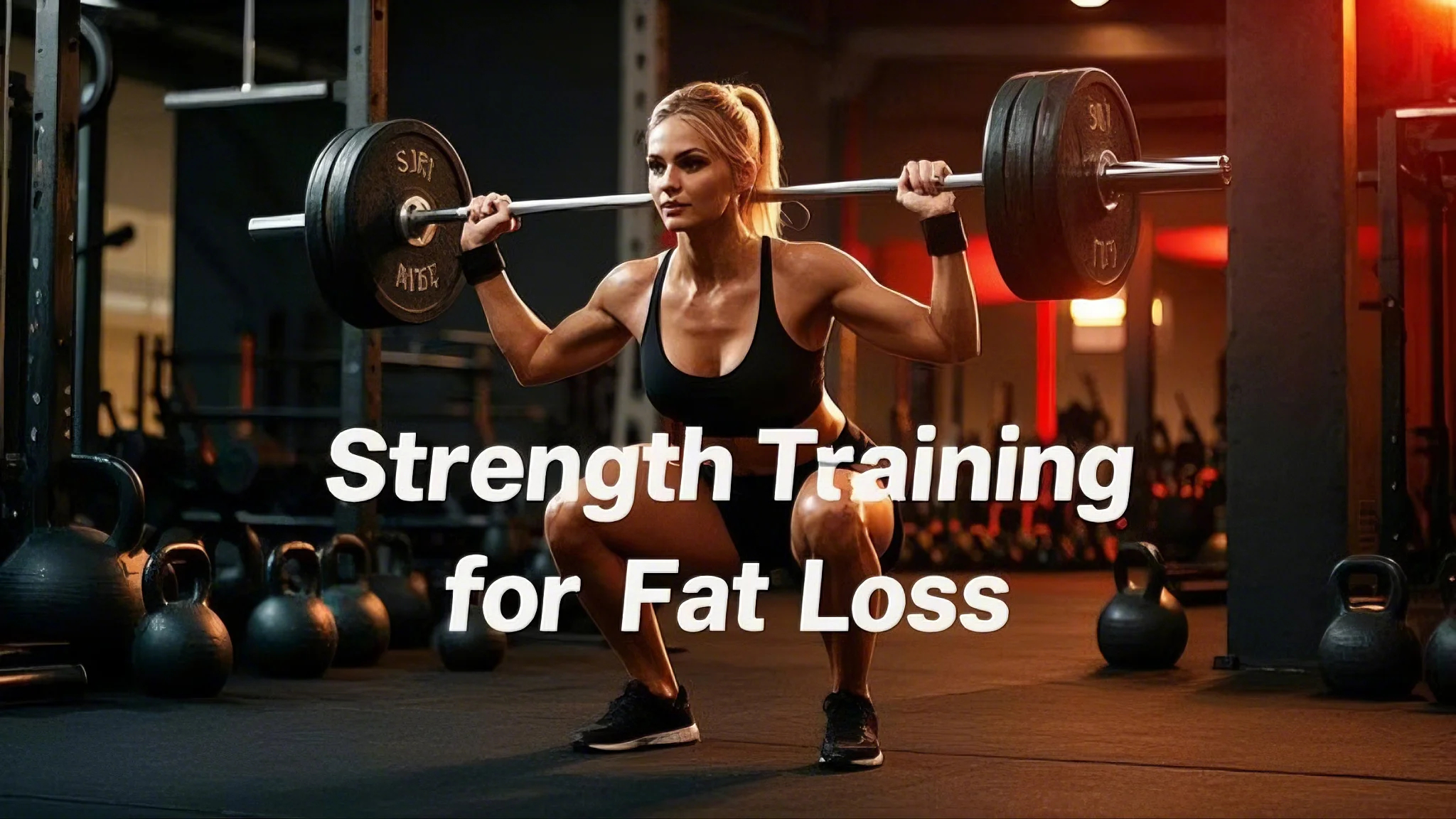Strength Training for Fat Loss
Did you know that strength training can boost your metabolism for up to 48 hours after your workout? That’s right—your body keeps burning calories even while you’re binge-watching your favorite show. If you’re looking to shed fat while building lean muscle, this is your golden ticket.
Strength training isn’t just about lifting heavy weights. It’s about using tools like dumbbells, kettlebells, and even your own body weight to challenge your muscles. The key? Progressive overload—gradually increasing the intensity to keep your body guessing and growing.
Why does it work so well? When you build muscle, your body burns more calories at rest. Plus, exercises like push-ups, squats, and kettlebell raises are efficient and effective. They help you torch fat while sculpting a stronger, leaner physique.
In this article, you’ll discover workout routines, nutrition tips, and how to avoid injuries. Whether you’re a gym newbie or a seasoned lifter, we’ve got you covered. Let’s get moving!
Understanding the Basics of Strength Training
Ever wondered why strength training is a game-changer for fat loss? It’s not just about lifting heavy weights—it’s about challenging your muscles in ways that transform your body. Whether you’re using dumbbells, resistance bands, or just your own body weight, this form of exercise builds strength, burns fat, and boosts overall health.
What is Strength Training?
Strength training, also known as resistance training, involves exercises that improve muscle strength and endurance. Unlike cardio, which focuses on heart health, strength training targets your muscles through activities like weightlifting, push-ups, and squats. It’s versatile—you can do it at the gym or at home with minimal equipment.
Key Benefits for Fat Loss and Overall Health
Strength training offers a range of benefits that go beyond fat loss. It increases your metabolic rate, helping you burn calories even at rest. Here’s a quick breakdown of its advantages:
- Improved Muscle Tone: Builds lean muscle, giving you a more defined physique.
- Increased Bone Density: Reduces the risk of osteoporosis by strengthening bones.
- Enhanced Metabolic Function: Boosts calorie burn, aiding in weight management.
Proper form and technique are crucial. They prevent injuries and ensure you get the most out of every movement. Whether you’re lifting weights or doing bodyweight exercises, focus on controlled, deliberate motions.
| Exercise Type | Reps | Sets | Rest Period |
|---|---|---|---|
| Weightlifting | 8-12 | 1-3 | 30-60 sec |
| Bodyweight | 12-15 | 1-3 | 20-30 sec |
| Resistance Bands | 10-12 | 1-3 | 30 sec |
Whether you’re at the gym or working out at home, strength training is accessible and effective. Start with lighter weights and gradually increase intensity to see results. Remember, consistency is key!
The Science Behind Fat Loss and Muscle Building
Your muscles don’t just move—they’re also fat-burning machines. When you engage in training, your body taps into stored fat to fuel your workout. This process is like turning on a furnace that keeps burning even after you’ve finished exercising.
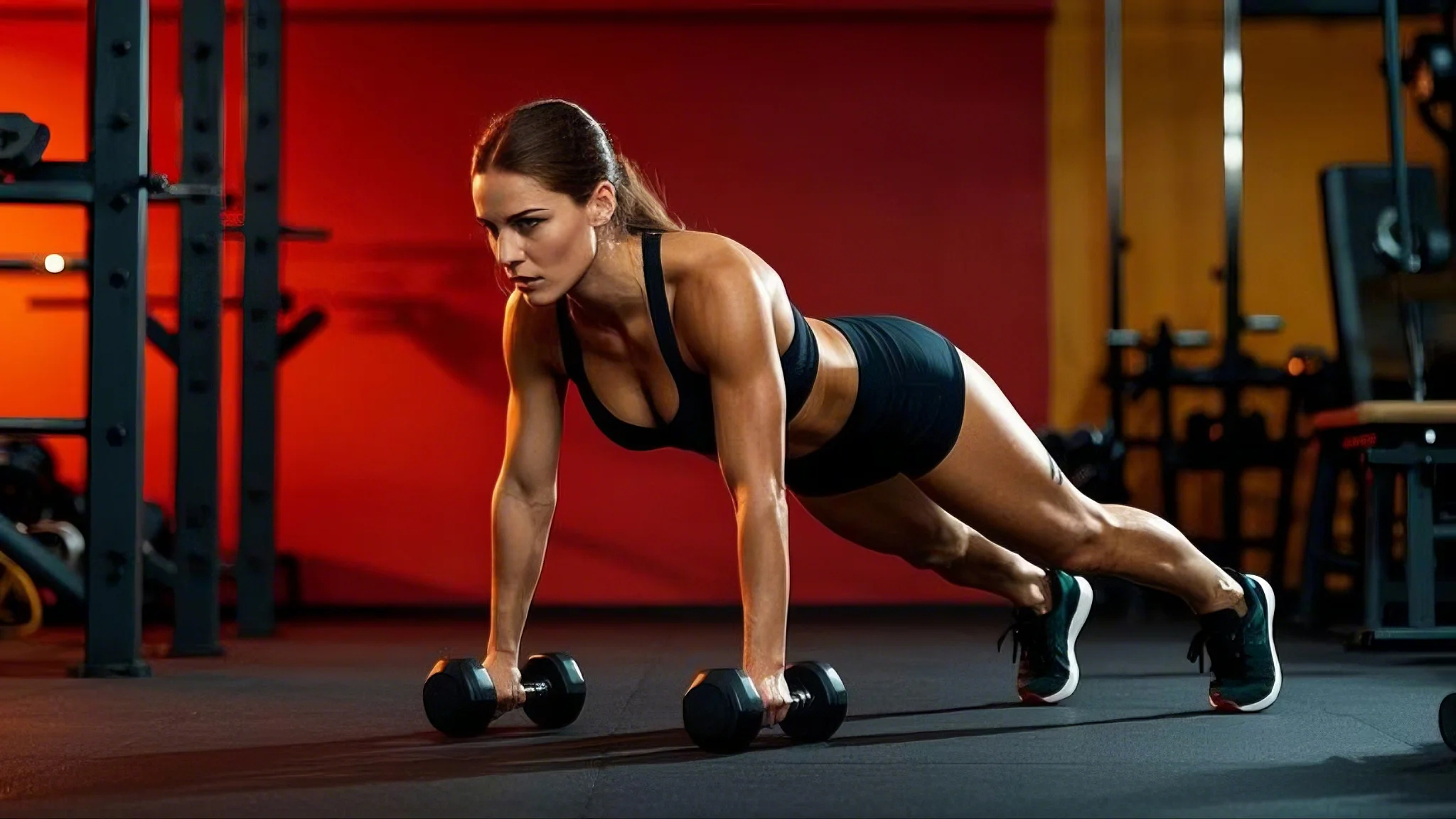
How Muscles Burn Fat
During exercise, your muscles break down fat into fatty acids and glycerol. These are then converted into energy. Think of it as your body’s way of using stored fat as fuel. The more intense your workout, the more fat your muscles burn.
Blood circulation plays a key role here. As your heart pumps faster, it delivers oxygen-rich blood to your muscles. This helps them work efficiently and burn fat effectively. It’s like giving your muscles a turbo boost!
The Role of Progressive Overload
Progressive overload is the secret sauce for muscle growth and fat loss. It means gradually increasing the resistance or intensity of your training. This challenges your muscles, forcing them to adapt and grow stronger.
For example, if you’re lifting weights, you might add a little more weight each week. Or, if you’re doing bodyweight exercises, you could increase the number of reps. This constant challenge keeps your muscles guessing and your metabolism revved up.
| Exercise | Reps | Sets | Progression |
|---|---|---|---|
| Squats | 12-15 | 3 | Add 5 lbs weekly |
| Push-ups | 10-12 | 3 | Increase reps by 2 |
| Deadlifts | 8-10 | 3 | Add 10 lbs weekly |
By incorporating progressive overload, you’re not just building muscle—you’re also boosting your body’s ability to burn fat. It’s a win-win for your fitness goals!
Essential Principles of Resistance Training for Transformation
What if the secret to transforming your body lies in how you challenge it? Resistance training isn’t just about lifting weights—it’s about applying smart strategies to maximize results. Whether you’re aiming to build muscle, burn fat, or improve overall fitness, understanding these principles can make all the difference.
Progressive Overload and Training Volume
Progressive overload is the cornerstone of effective resistance training. It means gradually increasing the weight or intensity of your workouts to keep your muscles adapting. For example, if you’re bench pressing 100 lbs this week, aim for 105 lbs next week. This constant challenge is what drives muscle growth and fat loss.
Training volume—how much you lift in a session—also plays a crucial role. Too little volume won’t stimulate growth, while too much can lead to burnout. A balanced approach, like 3 sets of 8-12 reps, ensures you’re working hard without overdoing it.
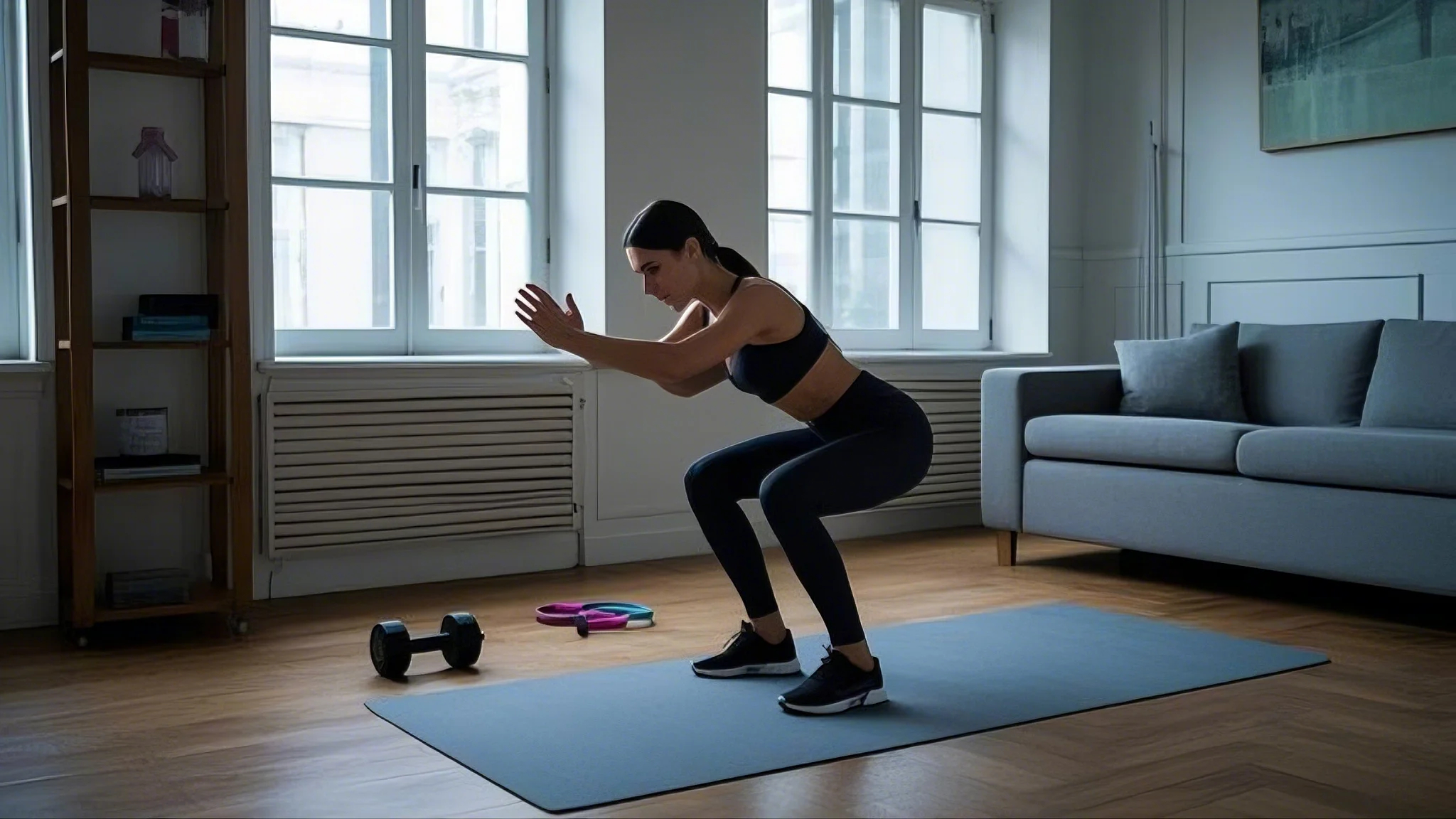
Balancing Aerobic and Anaerobic Activities
While resistance training focuses on building strength, combining it with aerobic activities like running or cycling can enhance your results. Aerobic exercises improve cardiovascular health, while anaerobic activities (like lifting weights) build muscle and boost metabolism.
For example, you could start your workout with 10 minutes of cardio to get your heart pumping, followed by a focused resistance training session. This balance ensures you’re working on both endurance and strength.
| Principle | Description | Example |
|---|---|---|
| Progressive Overload | Gradually increase weight or intensity | Add 5 lbs to your squat each week |
| Training Volume | Total work done in a session | 3 sets of 10 reps |
| Activity Balance | Mix aerobic and anaerobic exercises | Cardio + weightlifting |
By mastering these principles, you’ll not only see better results but also enjoy a more structured and effective training routine. Remember, it’s not just about the time you spend working out—it’s about how you use that time to challenge your body.
Getting Started with Strength-Training: A Beginner’s Guide
Starting your fitness journey can feel overwhelming, but it doesn’t have to be. Whether you’re stepping into a gym for the first time or working out at home, the key is to start smart. Begin by assessing your current fitness level and setting realistic goals. This approach ensures your training is tailored to your individual needs.
Assessing Your Fitness and Setting Goals
Before diving into a workout routine, take a moment to evaluate where you are. Can you do 10 push-ups? How about a 5-minute jog? Knowing your starting point helps you set achievable goals. For example, aim to increase your push-ups by two each week or jog for an extra minute every day.
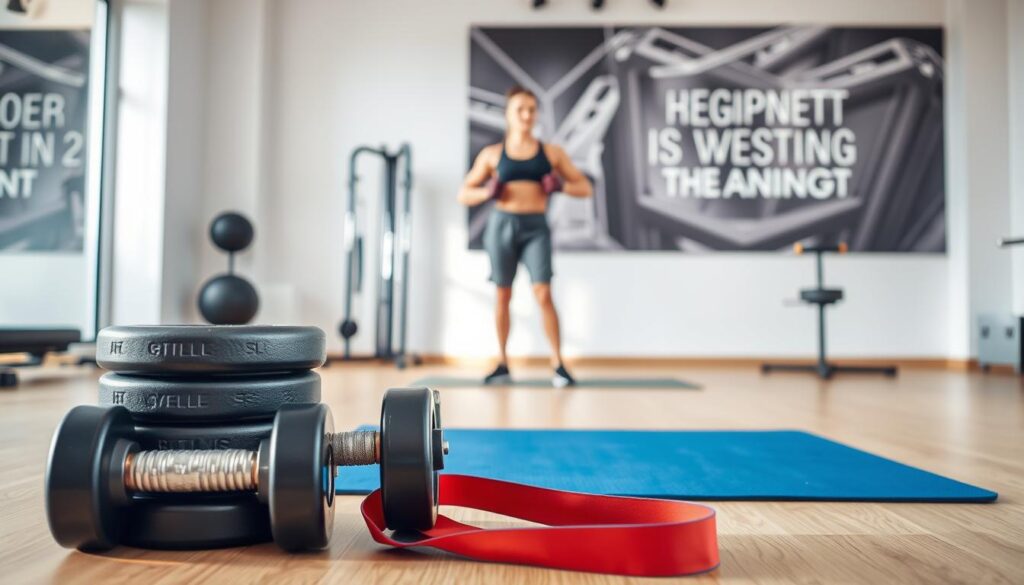
Setting small, measurable goals keeps you motivated. Instead of saying, “I want to get fit,” try, “I’ll complete three exercise sessions this week.” This clarity makes it easier to track progress and celebrate wins along the way.
If you’re unsure where to start, consider consulting a trainer. They can create a personalized plan that matches your fitness level and goals. Remember, it’s not about being perfect—it’s about making consistent progress.
| Goal Type | Example | Timeline |
|---|---|---|
| Strength | Increase squat weight by 10 lbs | 4 weeks |
| Endurance | Run 1 mile without stopping | 6 weeks |
| Flexibility | Touch toes in a forward bend | 2 weeks |
Starting with proper form is crucial. Focus on mastering basic movements like squats, lunges, and push-ups. These foundational exercises build confidence and reduce the risk of injury. As you progress, you can add more complex moves to your routine.
Remember, everyone starts somewhere. Take it one day at a time, and soon you’ll see the results of your hard work. The gym might seem intimidating at first, but with the right approach, it can become your favorite place to train.
Proper Form and Technique to Prevent Injuries
Good form isn’t just about looking good—it’s about staying safe. Proper form reduces the risk of strains, fractures, and joint damage. It’s the foundation of effective training and injury prevention.
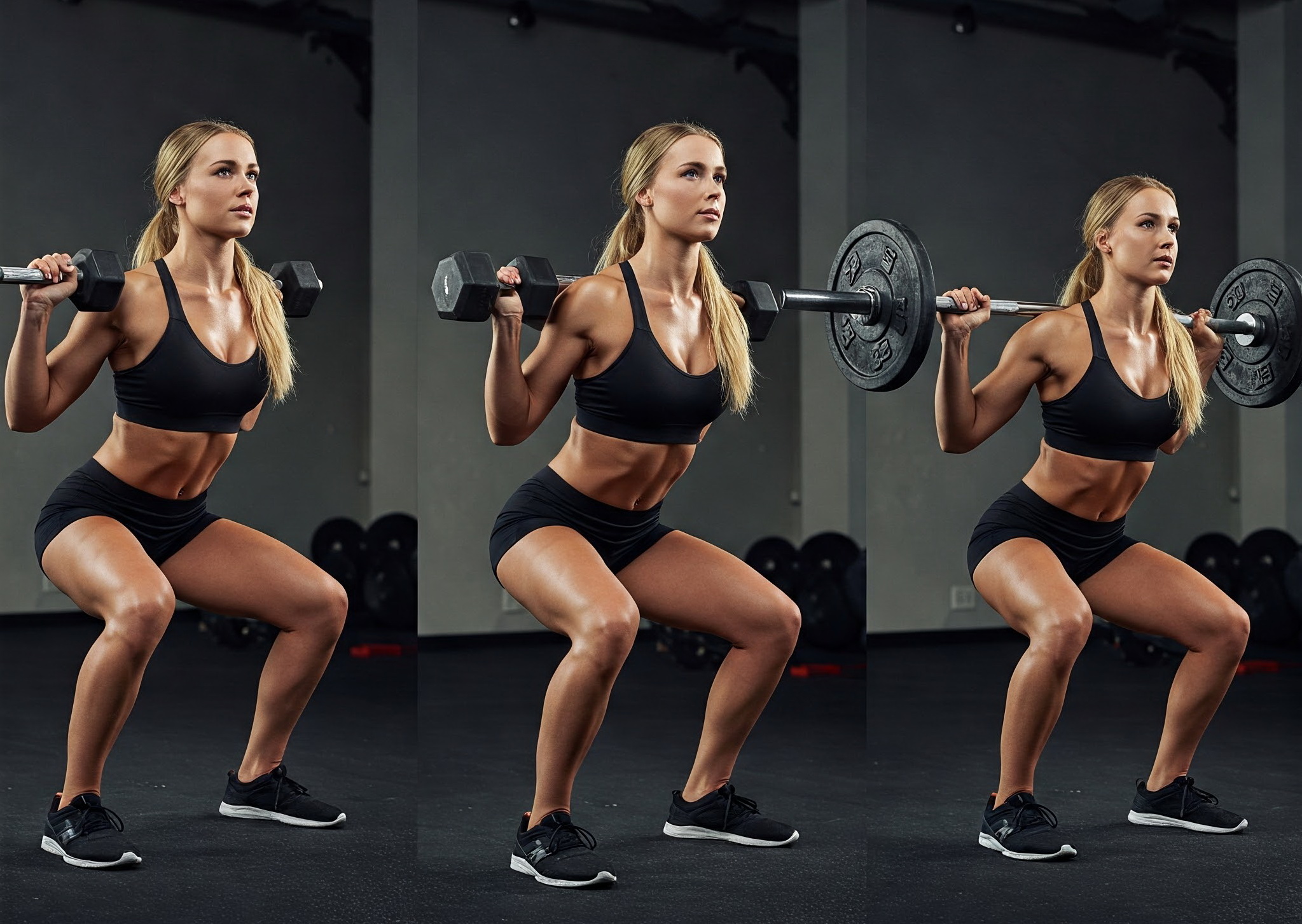
Mastering Correct Movement Patterns
Mastering correct movement patterns is key to staying safe. Whether you’re squatting, deadlifting, or using dumbbells, focus on controlled, deliberate motions. For example, during a squat, keep your chest up and knees aligned with your toes.
Here’s a quick guide to common exercises:
| Exercise | Key Form Tips |
|---|---|
| Squats | Keep chest up, knees aligned with toes. |
| Deadlifts | Maintain a neutral spine, hinge at hips. |
| Dumbbell Press | Engage core, avoid arching back. |
Tips for Avoiding Common Mistakes
Poor technique increases the risk of injury. Common mistakes like rounding your back during deadlifts or locking your knees during squats can lead to serious injuries. Here’s how to avoid them:
- Start Light: Use lighter weights to perfect your form before increasing intensity.
- Engage Your Core: A strong core stabilizes your body and protects your spine.
- Use Mirrors: Check your form in real-time to make corrections on the spot.
Choosing the right equipment, like dumbbells, is crucial. Proper lifting techniques protect your joints and muscles. Remember, it’s better to lift lighter with good form than heavier with poor technique.
Importance of Warm-Up, Stretching, and Recovery
Ever thought about why your workout feels smoother after a good warm-up? It’s not just about getting your body moving—it’s about preparing your muscles, reducing injury risk, and boosting performance. A proper warm-up and recovery routine can make all the difference in your training.

Effective Warm-Up Routines
Starting your workout with a warm-up is like revving an engine before a race. It increases muscle temperature, improves flexibility, and gets your heart pumping. Aim for 5 to 10 minutes of low-intensity activity, like jogging or dynamic stretches, before diving into your main routine.
Here’s a simple warm-up plan you can follow:
| Activity | Duration | Purpose |
|---|---|---|
| Light Jogging | 3 minutes | Increase heart rate |
| Arm Circles | 1 minute | Loosen shoulder joints |
| Leg Swings | 1 minute | Improve hip mobility |
As the NY Sports Medicine Institute emphasizes, warming up prepares you physically and mentally for exercise, reducing the risk of injury.
Incorporating Active Recovery Strategies
Recovery isn’t just about resting—it’s about helping your body repair and rebuild. Active recovery strategies, like foam rolling and mobility exercises, can reduce muscle soreness and keep you ready for your next workout.
Here are some tips to enhance your recovery:
- Foam Rolling: Helps release muscle tension and improve blood flow.
- Dynamic Stretching: Keeps muscles flexible and reduces stiffness.
- Hydration: Replenishes fluids lost during exercise.
“Active recovery is the bridge between workouts. It keeps your body in motion without overloading it.”
By incorporating these strategies, you’ll not only recover faster but also maintain momentum in your training routine. Remember, a little effort in warm-up and recovery goes a long way in keeping you injury-free and performing at your best.
Crafting the Perfect Workout Routine
Creating a workout plan that works for you doesn’t have to feel like solving a puzzle. The key is to balance compound and isolation exercises while structuring your sessions for maximum results. Whether you’re aiming to build muscle, burn fat, or both, a well-designed routine can make all the difference.
Selecting Compound Versus Isolation Exercises
Compound exercises, like squats and deadlifts, work multiple muscle groups at once. They’re efficient and great for building overall strength. Isolation exercises, such as bicep curls, target specific areas like your arms. Both have their place in a balanced routine.
For example, squats engage your legs, core, and glutes, while bicep curls focus solely on your arm muscles. Combining these exercises ensures you’re working all major muscle groups effectively.

Structuring Daily and Weekly Sessions
Planning your workouts by the week helps you stay consistent. Aim for 3-4 sessions per week, alternating between muscle groups. This allows time for recovery while keeping your progress steady.
Here’s a sample weekly plan:
| Day | Focus | Exercises |
|---|---|---|
| Monday | Legs & Core | Squats, Lunges, Planks |
| Wednesday | Upper Body | Push-ups, Dumbbell Press, Rows |
| Friday | Full Body | Deadlifts, Burpees, Pull-ups |
Remember, recovery is just as important as the workout itself. Rest days give your muscles time to repair and grow stronger.
For more tips on building a personalized routine, check out this guide from Nerd Fitness.
The Role of Nutrition in Strength Training and Fat Loss
Nutrition is the unsung hero of your fitness journey, quietly shaping your results. What you eat fuels your workouts, repairs muscle, and helps you achieve your fitness goals. Without the right diet, even the most intense training sessions can fall short.
Balancing macronutrients—carbs, proteins, and fats—is key. Each plays a unique role in fueling your body and supporting muscle gain. Let’s break it down.
Balancing Macronutrients for Muscle Gain
Protein is essential for repairing muscle after a workout. Aim for 1.2 to 1.7 grams of protein per kilogram of body weight daily. For a 150-pound person, that’s about 95 to 136 grams. Foods like chicken, eggs, and Greek yogurt are great sources.
Carbohydrates provide energy for your workouts. Whole grains, fruits, and veggies are your best bets. Fats, often misunderstood, are crucial for hormone production and overall health. Avocados, nuts, and olive oil are excellent choices.
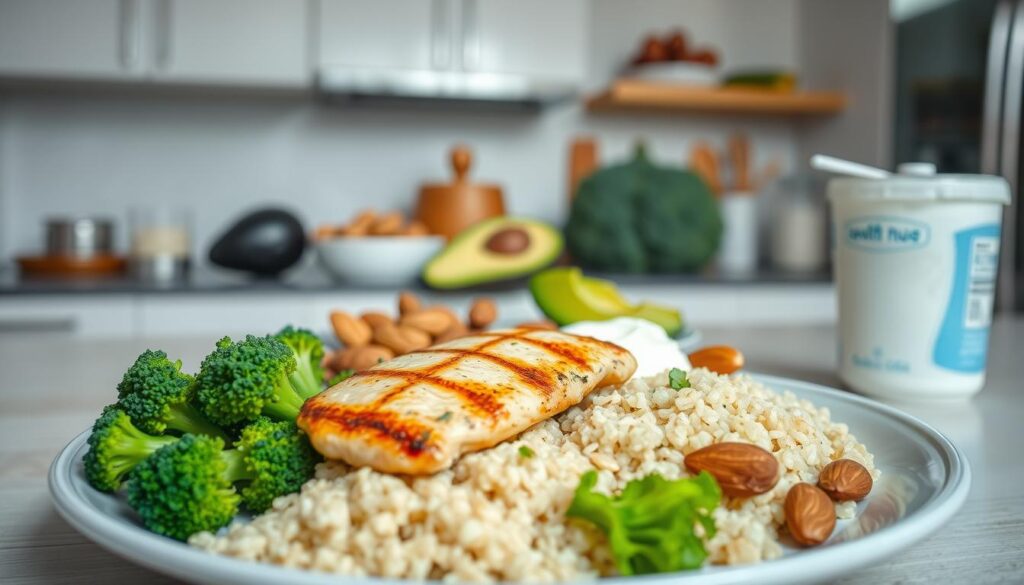
Meal Timing and Pre/Post Workout Snacks
When you eat is just as important as what you eat. A pre-workout snack 30 to 60 minutes before training can boost your energy. Try a banana with peanut butter or a small smoothie.
After your workout, focus on recovery. A mix of protein and carbs helps repair muscle and replenish energy. A protein shake with a piece of fruit or a turkey sandwich on whole-grain bread works well.
Here’s a quick guide to meal timing:
| Meal | Timing | Example |
|---|---|---|
| Pre-Workout | 30-60 mins before | Banana + Peanut Butter |
| Post-Workout | Within 30 mins | Protein Shake + Fruit |
| Daily Intake | Spread throughout day | Balanced meals + snacks |
Combining proper nutrition with strength training is the ultimate recipe for success. It helps you lose weight, maintain muscle, and feel your best. Remember, your diet is just as important as your workout plan.
Using Equipment Effectively and Home Workout Alternatives
What’s the best way to maximize your workout results? It starts with the right equipment. Whether you’re at the gym or working out at home, the tools you use can make a big difference in your progress. Let’s explore the options and find what works best for you.
Choosing Between Free Weights and Machines
Free weights, like dumbbells and barbells, are versatile and great for building functional strength. They engage multiple muscle groups and improve balance. Machines, on the other hand, are excellent for isolating specific muscles and reducing the risk of injury. Both have their place in a well-rounded routine.
For beginners, machines can provide stability and help you learn proper form. As you advance, incorporating free weights can challenge your body in new ways. It’s all about finding the right balance for your fitness level and goals.
Bodyweight Exercises and Resistance Bands
Don’t have access to a gym? No problem. Bodyweight exercises like push-ups, squats, and lunges are effective and require no equipment. They mimic gym movements and can be done anywhere. Resistance bands add an extra challenge, making them perfect for home workouts.
Here’s a quick comparison of gym and home workout options:
| Option | Pros | Cons |
|---|---|---|
| Gym Equipment | Variety, stability, advanced options | Cost, accessibility |
| Home Workouts | Convenience, affordability, flexibility | Limited equipment, space constraints |
Whether you’re lifting weights or using your body, the key is consistency. Choose the equipment that fits your lifestyle and keeps you motivated. Remember, the best workout is the one you’ll stick with!
Advanced Tactics: Tempo, Splits, and Periodization
Ready to take your fitness to the next level? Advanced tactics can make all the difference. Whether you’re looking to break through plateaus or optimize your routine, understanding tempo, splits, and periodization can elevate your results.
Manipulating Movement Tempo
Movement tempo refers to the speed at which you perform each repetition. By varying the tempo, you can target different muscle fibers and increase overall activation. For example, slowing down the eccentric (lowering) phase of a squat can enhance muscle growth and control.
Studies show that tempo manipulation can help overcome plateaus. A slower tempo increases time under tension, which is key for muscle development. On the other hand, a faster tempo can improve power and explosiveness.

Understanding Periodization and Training Splits
Periodization is a structured way to organize your training over time. It involves dividing your program into phases, each with a specific focus. This approach keeps your workouts challenging and prevents burnout.
Training splits, like upper/lower or push/pull/legs, ensure you’re working all muscle groups effectively. Block periodization, where you focus on one goal (e.g., strength) for several weeks, is backed by scientific studies for its effectiveness.
| Training Phase | Focus | Duration |
|---|---|---|
| Hypertrophy | Muscle Growth | 4-6 weeks |
| Strength | Maximal Strength | 4-6 weeks |
| Power | Explosiveness | 2-4 weeks |
By incorporating these advanced tactics, you’ll not only see better results but also keep your workouts fresh and exciting. Remember, the key is to work smarter, not harder.
Incorporating Cardio and Complementary Exercises
Ever considered how cardio can amplify your fitness results? Combining it with strength training isn’t just about burning calories—it’s about boosting your overall health and performance. Research shows that pairing these two can enhance heart health, improve endurance, and accelerate fat loss.

Optimizing Workouts for Heart Health
Cardio isn’t just for runners. Adding even 10 to 15 minutes of moderate-intensity cardio to your workout can significantly improve cardiovascular health. Activities like brisk walking, cycling, or jumping rope get your heart pumping and increase blood flow to your muscles.
Here’s why it works: cardio strengthens your heart, while strength training builds muscle. Together, they create a balanced fitness routine that supports long-term health.
When to Integrate Cardio with Strength Sessions
Timing matters when combining cardio and strength training. For fat loss, consider doing cardio after your strength session. This ensures your energy is focused on lifting weights first. If endurance is your goal, start with cardio to warm up your body.
Short, high-intensity bursts of cardio, like 30-second sprints, can also complement resistance training. These quick sessions elevate your heart rate without overloading your muscles.
- Boost Energy Levels: Even a few extra minutes of cardio can increase your energy and focus.
- Enhance Recovery: Light cardio on rest days improves blood flow and reduces muscle soreness.
- Maximize Results: Combining both types of training ensures you’re working on strength and endurance simultaneously.
By integrating cardio into your routine, you’re not just improving your fitness—you’re building a stronger, healthier body. Start small, stay consistent, and watch your results soar.

Expert Tips for Staying Motivated and Tracking Progress
Staying motivated in your fitness journey can feel like a rollercoaster, but with the right strategies, it’s entirely manageable. Whether you’re just starting or hitting a plateau, tracking your progress and celebrating small wins can keep you on track.
Keeping a Training Log and Measuring Success
A training log is your secret weapon for staying consistent. Write down your workouts, weights, and reps to see how far you’ve come. It’s like a fitness diary that keeps you honest and motivated.
For example, if you’re lifting heavier weights or doing more reps than last week, that’s progress worth celebrating. A log also helps you identify patterns, like which exercises give you the best results or when you need to push harder.
Setting Realistic Goals and Celebrating Milestones
Setting a goal is great, but make sure it’s realistic. Instead of aiming to lose 20 pounds in a month, focus on smaller, achievable targets like adding 5 pounds to your squat or running an extra mile. These incremental wins keep you motivated.
Celebrating milestones is equally important. Did you hit a new personal best? Treat yourself to something you enjoy, like a new workout outfit or a relaxing massage. These rewards remind you that your hard work pays off.
“Small wins build momentum. Celebrate them, and you’ll stay motivated for the long haul.”
If you’re feeling stuck, consider working with a trainer. They can help you adjust your routine and set new challenges. Remember, every individual’s journey is unique, so focus on what works for you.
For more tips on staying motivated, check out this helpful guide.
Final Thoughts and Next Steps for Fat Loss Success
Achieving fat loss isn’t just about effort—it’s about strategy. Combining consistent training, proper nutrition, and smart recovery leads to lasting results and a healthier life. Every squat, pull, and session moves you closer to your goals.
Start by applying the techniques you’ve learned. Focus on progressive overload, balanced meals, and active recovery. Consistency is key—small, steady efforts lead to big changes over time.
Many have transformed their bodies by following this approach. Whether it’s shedding fat, building muscle, or improving overall health, the results speak for themselves. Your journey is unique, but the principles remain the same.
Ready to take the next step? Set realistic goals, track your progress, and celebrate milestones. Remember, every leg of your journey matters. Stay committed, and you’ll see the changes you’ve been working for.
Your healthier, stronger self is within reach. Keep pushing, and you’ll get there—one pull, one squat, one day at a time.
